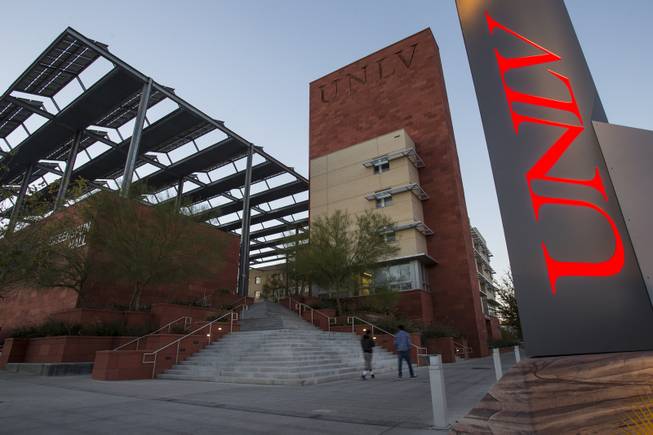
UNLV Photo Services
UNLV’s per-student share of state funding is about $1,700 less than that of UNR.
Tuesday, Dec. 11, 2018 | 2 a.m.
View more of the Sun's opinion section
Nevada’s higher education system suffers from a bloated administration, inequitable funding that favors UNR at the expense of other schools, mismanagement that has destroyed trust among donors, and a dismal graduation rate despite strong per-student funding from the state.
Those were among the key points of a presentation last week from the Lincy Institute at UNLV on higher education reform, which provided a sledgehammer of an argument for restructuring the governance of Nevada’s colleges and universities.
The examination yielded a lot of jaw-dropping moments — and not the good kind — but here were some of the most telling:
• A look at the instructional budgets of seven state institutions showed that only UNR has benefited under a reboot of the state funding formula in 2011. UNR’s percentage of state funding has gone up, while the share has gone down at UNLV, Desert Research Institute, the College of Southern Nevada, Truckee Meadows Community College, Western Nevada College and Great Basin College.
• UNLV’s per-student share of state funding remains about $1,700 less than UNR’s.
• Although Nevada ranks No. 20 among states in terms of providing state funding for higher education, it’s No. 45 in four-year college completion and is well below average nationally in graduation rates across all campuses. This is deeply disturbing, because improving graduation rates is an investment in Nevada’s future. Keeping students in state and establishing a pathway to success for them in higher education encourages business development, provides a high-quality workforce for employers and yields other benefits to the state. States succeed when their universities thrive.
• Several institutions in the state get less funding from the state than it allocates to the Nevada System of Higher Education. Those institutions include Great Basin College, Nevada State College, the UNLV School of Medicine and Western Nevada College.
• The funding formula disadvantages community colleges to the benefit of the universities, especially for smaller campuses in the north of the state.
It’s important to note here that the research behind the presentation was conducted by individuals with ties to UNLV — professors David Damore, who also serves as chair of the university’s political science department, and Robert Lang, the executive director of both the Lincy Institute and Brookings Mountain West. Also, the Lincy Institute is based at UNLV, where its mission is to foster improvement in Nevada’s health, education and social services.
But the presentation needs to be heard throughout the state. The upshot is that it’s past time for changes.
Among them:
• Equalize funding for UNR and UNLV.
• Roll back a 2005 change in administrative structure that gave the chancellor the ability to discipline university presidents and force them out. Amid accusations of micromanagement and North-South turf battling, UNLV is on its sixth leader since that change. Most recently, the pressured resignation of Len Jessup triggered the loss of major donations to the UNLV School of Medicine, with donors citing lack of trust in the regents and chancellor to manage their gifts.
• Split off the community colleges and state colleges (Great Basin College, Nevada State College, etc.) into their own system, overseen by a board appointed by the governor. Currently, Nevada is among only four states whose universities, community colleges and state colleges are all overseen by a single governing board and administrative agency. And the others — Hawaii, Alaska and North Dakota — have a combined population of Nevada’s.
Again, there’s much more ground to cover than we can present here.
But the presentation is a must-see for all state leaders and legislators, especially those from the South. Simply put, UNLV needs champions in the Legislature who realize the critical role that the university plays, not only as the leading higher education institution in Southern Nevada but as an asset in the city that drives the economy of the entire state.
To his credit, state Sen. Joe Hardy, R-Las Vegas, attended the event. But unfortunately, he was the only elected leader in the crowd.
For those who weren’t there, video and slides from the presentation are available. We’d encourage readers to share it on social media and to forward the link to their state legislators.
